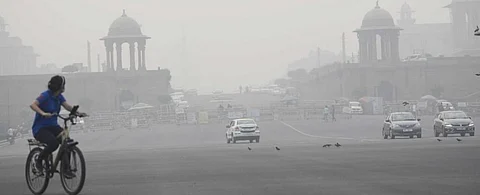

The residents of Delhi and the National Capital Region (NCR) continued to breathe toxic air as air quality in the national capital remained in the ‘severe’ category for the sixth straight day November 10, 2020.
No recovery is expected any time soon, even as Diwali is just four days away. There was no relief from the heavy smog either as it kept hanging on the city, obliterating any chance of sunlight.
The National Green Tribunal has ordered a total ban on the sale or use of all kinds of fire crackers in the NCR from the midnight of November 9-10 till the midnight of November 30-December 1, 2020. Conditions in the region will worsen post-Diwali night, if people flout the ban.
A chance of light rain during the Diwali weekend due to an active western disturbance over the hills of north India could further aggravate the pollutant load.
While a good shower washes off pollutants, light rain worsens the already high pollution level. This is because it leads to an increase in moisture, which further traps pollutants in the air, instead of dispersing them.
The concentration of poisonous pollutants like Particulate Matter (PM)2.5 and PM10 November 10 was more than eight times their prescribed standards.
While the value of PM2.5 was recorded at 527 microgramme per cubic metre (μg / m3), PM10 was at 819 μg / m3. PM2.5 are particles less than 2.5 microns in size and capable of entering human lung and blood tissue.
The prescribed standards by the World Health Organization (WHO) are 60 and 100 μg / m3 respectively.
An analysis by SAFAR (System of Air Quality and Weather Forecasting and Research) under the Union Ministry of Earth Sciences, called the November 10 pollution levels an ‘unusual situation’.
The analysis attributed it mainly to meteorological factors like high moisture content and extremely calm surface winds that continued to arrest all old and new accumulated pollutants.
“Due to entry of high moisture content, humidity touched a new high and the air holding capacity increased under such cool conditions, triggering rapid secondary fine particulate formation,” the analysis said.
It added that this was a scientific process wherein gas-to-particle conversion happens and “in-situ chemical production takes place on available surfaces and multiply PM2.5”.
“Due to favourable transport level wind direction and speed until today morning, significant stubble burning-related intrusion took place. But now, the transport level winds have reversed and may reduce stubble intrusion,” it said.
However, the analysis pointed out that due to the weather factors, no quick recovery was forecast, unless moisture content declined.
The average Air Quality Index (AQI) for Delhi, as reported by the Central Pollution Control Board (CPCB) was 476. The value was the highest among all cities and towns for which data was being recorded by CPCB.
An AQI of 0-50 is considered ‘good’, 51-100 ‘satisfactory’, 101-200 ‘moderate’, 201-300 ‘poor’, 301-400 ‘very poor’, and 401-500 ‘severe’. Above 500 is the ‘severe-plus or emergency’ category.
The NCR towns of Ghaziabad, Faridabad, Noida, Greater Noida and Gurugram also experienced ‘severe’ air quality.